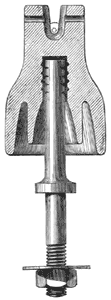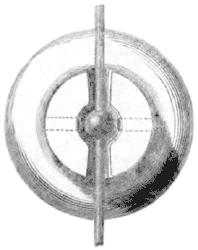CAPANEMA'S PATENT PORCELAIN
INSULATOR FOR BULLET-SHAPED
WIRE-ATTACHMENT.
BEFORE describing this insulator we think it advisable to give a brief summary of the causes which lead to the decrease of electrical resistance observed in so many insulators after erection. It is not sufficient that a high insulating power is observed shortly after manufacture, but it is of the first importance that this insulation should remain as constant as possible, and Capanema's insulator has been designed to fulfill shis condition. Decrease of insulation or electrical resistance may, be traced to the following causes:
(1.) Chemical action which is set up when insulators of inferior quality are exposed to an atmosphere impregnated with acids or salts. (Porcelain insulators are less liable to be injured in this way than those of ebonite.)
(2.) Conducting films of dust and moisture, which frequently collect on the surface of insulators, and more readily upon a rough than a smooth surface.
(3.) Fissures and cracks caused by sudden and unequal expansion or contraction of the whole insulator or some of its parts. (The materials may, however, be so combined as to reduce this defect to a minimum. The quality and proportions of the substances employed in the manufacture of the porcelain should be chosen with a view of securing as constant an electrical resistance as practicable.)
(4.) Fissures caused by discharges of atmospheric electricity passing from the line-wire through the insulator to earth. (This occurs more readily when the insulator is of inferior quality, especially when the line-wire is attached to it by binding wire. In this case the latter, by encircling the upper part of the insulator, causes a large number of metallic points to be in contact with it, thus assisting the discharge through weak and defective places on the surface.)
(5.) The use of binding wire which frequently breaks and forms a direct contact. (When binding wire is wound round the insulator, its coating of zinc is invariably chafed off. It then rapidly oxidises through the moisture of the atmosphere, and rust is deposited over the surface of the insulator, thereby greatly reducing the insulation.)
Description of Capanema's Insulator
This insulator has been designed with a view to avoid the above causes of defective insulation, and to obtain a method of securely fastening the line-wire to the insulator, while at the same time allowing repairs to be easily effected in case of breakage. The wire is securely attached to each insulator, so that in the event of a break occurring in any span, the insulators on each side hold the fractured wires and prevent them from slipping back in the adjoining spans.
 |
| Fig. 1. |
Fig. 1 shows a section and fig. 2 a plan of this insulator. When a line is being constructed the wire is strained from pole to pole, and the place where it will rest in the insulator is marked. A bullet-shaped piece of tin-solder (the same as used for soldering joints) is then east upon the wire at this mark and placed in the insulator. In the porcelain just above the bullet, there are two small holes for the reception of a pin which serves to keep the wire in its place. On properly-constructed lines, however, the wire is retained in the insulator by its own weight, and the pin is only required when the line has been erected in an irregular manner.
 |
| Fig. 2. |
Experience has proved that the wire does not slip through the bullet, and that both are capable of bearing an equal strain. In order, however, to obtain complete security against slipping, the line-wire should be first dipped into the molten tin solder and heated, and the bullet then cast upon it, when the union of the metals becomes complete.
To facilitate this operation a bullet mould is used, through which the tin is allowed to flow, thus heating the wire, and after the latter has been sufficiently heated, the outflow of metal is stopped by a shutter, and the bullet is then formed. If the wire is not previously heated as above described, it slips through the bullet, just before its breaking strain is reached.
These insulators, which are of double-cup form, are made of the best highly-glazed porcelain, and the disadvantages attending the use of binding-wire (referred to in paragraphs 4 and 5), are avoided by the adoption of the form of attachment. The line-wire, by means of this attachment, touches the insulator only at one point, so that discharges of atmospheric electricity are much lees likely to destroy the insulator than when binding-wire is employed.
The method of fastening the line-wire by means of binding wire round each insulator is objectionable on account of its giving rise to loss of current during damp weather. In Capanema's insulator this leakage is greatly reduced by the small point of contact between the insulator and line-wire, and the electrical resistance remains consequently more constant.
Another advantage of the bullet attachment is, that it offers an easy and substantial way of suspending the line-wire, and in such a manner that the swinging motion of the latter is rendered harmless, and when faulty insulators require renewal, that operation can be carried out without touching the wire and interfering with the correspondence on the line.
These qualities render the insulator especially suitable for long lines with few wires in countries where constant supervision and repairs are difficult.
The favourable results obtained induced the Brazilian Government State Telegraph Department to adopt this insulator, and their lines, which are over 10,000 kilometres in length, have thereby been greatly improved in insulation.
In the discussion (on Mr. Sivewright's paper) which took place at a meeting of the Society of Telegraph Engineers on April 9th, 1879, Mr. Andrew Bell, Superintendent of the British Postal Telegraph Factories, referred to Capanema's insulator as possessing some "excellent features," and farther remarked that "the metallic, or wire surface in contact with the insulator being very small diminished leakage, and another good point was that it would be free from a serious defect that attends the use of the common wire-binding. When the galvanising wears off the line and binding-wire, an oxide of iron soon covers the surface of the insulator and causes great leakage." These articles are manufactured by the firm of Messrs. Siemens Bros. & Co.

|